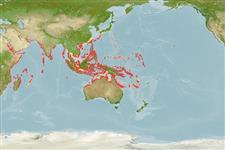Common names from other countries
Environment: milieu / climate zone / depth range / distribution range
Sinh thái học
Cùng sống ở rạn san hô; Mức độ sâu 0 - 30 m (Ref. 848). Tropical; 36°N - 23°S, 32°E - 175°E (Ref. 848)
Indo-West Pacific: Red Sea, Indonesia to Melanesia, north to Japan and south to Australia.
Length at first maturity / Bộ gần gũi / Khối lượng (Trọng lượng) / Age
Maturity: Lm ? range ? - ? cm
Formation: encrusting, can be submassive; small colonies have a conspicuous central corallite. Corallites: plocoid; becomes widely spaced at colony edges. Septa: with long pointed teeth. Fleshy tissue over skeleton present. Color: dark brown, rust red, or green (Ref. 848).
Occurs in protected reef environments (Ref. 848).
Life cycle and mating behavior
Chín muồi sinh dục | Sự tái sinh sản | Đẻ trứng | Các trứng | Sự sinh sản | Ấu trùng
Members of the class Anthozoa are either gonochoric or hermaphroditic. Mature gametes are shed into the coelenteron and spawned through the mouth. Life cycle: The zygote develops into a planktonic planula larva. Metamorphosis begins with early morphogenesis of tentacles, septa and pharynx before larval settlement on the aboral end.
Veron, J.E.N. 2000. (Ref. 848)
IUCN Red List Status (Ref. 130435)
CITES status (Ref. 108899)
Not Evaluated
Human uses
| FishSource |
Các công cụ
Thêm thông tin
Age/SizeSự sinh trưởngLength-weightLength-lengthHình thái họcẤu trùngSự phong phú
Các nguồn internet
Estimates based on models
Preferred temperature
(Ref.
115969): 25.5 - 29.3, mean 28.6 (based on 3339 cells).
Price category
Unknown.
